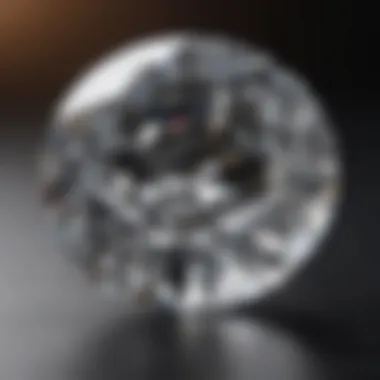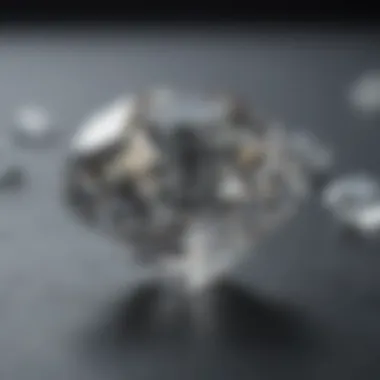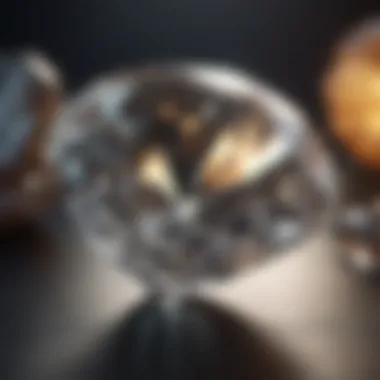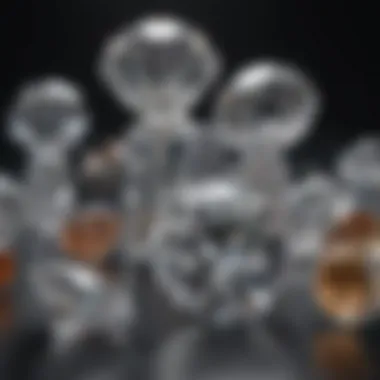Understanding Diamond Weight: Carat and Value Insights


Intro
Diamond weight is a critical factor in the evaluation of gemstones. It impacts not only the value of the diamond but also its overall appearance. Understanding how weight and carat measurement interrelate is essential for anyone considering purchasing diamonds. This section serves as a foundation for exploring the intricacies of diamond weight, its significance in valuation, and how it influences the perceptions of buyers and collectors.
Gemstone Overview
Diamonds are crystalline forms of carbon, cherished for their brilliance and hardness. They are often classified as precious gemstones and are primarily used in jewelry. Diamonds occur in various colors, although the most renowned is the colorless variety, often used in engagement rings and other fine jewelry.
In terms of physical properties, diamonds are known for their exceptional hardness, rated 10 on the Mohs scale. This characteristic makes them highly resistant to scratches and wear. Their high refractive index contributes to their sparkling appearance, making them particularly desirable in the luxury market.
Interestingly, diamonds can also form in different shapes and cuts, which affect how they reflect light, enhancing their visual appeal. Common diamond cuts include round, princess, emerald, and oval. These variations add complexity to their evaluation, especially when considering how weight affects their size and appearance.
The Significance of Carat in Valuation
Carat weight serves as a standard measurement unit for diamonds. One carat is equivalent to 200 milligrams. While larger carat weights generally indicate a higher value, several factors govern the overall valuation of diamonds.
- Color: The presence of color can diminish a diamond's value.
- Clarity: Inclusions or blemishes affect transparency.
- Cut Quality: The skill with which a diamond is cut impacts its brilliance.
Impact on Pricing
When it comes to pricing, the relationship between carat weight and the price per carat is not linear. As the weight of a diamond increases, the price can escalate exponentially. This phenomenon arises because larger diamonds are rare.
"A diamond's price does not only hinge on weight; it can also be influenced by market demand and trends."
Closure
A thorough understanding of diamond weight is indispensable for informed purchases. Recognizing how carat measurement correlates with appearance and valuation will aid collectors and enthusiasts alike. By focusing on the nuances of weight and its broader implications, buyers can navigate the diamond market with confidence.
Defining Diamond Weight
Defining diamond weight is crucial for understanding how gemstones are valued in the market. The weight of a diamond, measured in carats, serves as a key indicator of its rarity and overall worth. A deeper comprehension of this measurement lends insight into what you are purchasing, making it easier to compare different stones effectively. In a market flooded with options, distinguishing between diamonds based on their weight facilitates informed decisions, therefore likely influencing both satisfaction and investment potential over the long term.
What is Carat Weight?
Carat weight refers to the size of a diamond, specifically measured in carats. One carat is equivalent to 200 milligrams, meaning that a higher number indicates a heavier and generally larger stone. For instance, a 1-carat diamond weighs 200 milligrams, whereas a 2-carat diamond weighs 400 milligrams. It is important to note that carat weight alone does not dictate a diamond's value. Other aspects, such as clarity and color, play significant roles.
Carat weight can be misleading because two diamonds of identical carat weights can have vastly different appearances. The distribution of weight varies depending on how the diamond is cut. A well-cut diamond can appear larger than its actual carat size due to its proportions and overall shape, making cut quality an essential consideration when assessing diamonds.
Measurement Units in Gemology
In gemology, carats are the standard unit of measuring a diamond's weight. This measurement system is recognized globally, ensuring consistency in the trade. Understanding other relevant measurement terms can also aid in comprehensive evaluations. For example:
- Points: Each carat is divided into 100 points. Thus, a diamond weighing 0.75 carats is often referred to as a 75-point diamond.
- Millimeters: While carats measure weight, millimeters are used to measure the dimensions of a diamond. This offers another layer of information during evaluation.
Incorporating various measurement systems into your knowledge expands your capability in showcasing or purchasing gemstones. It helps articulate qualities effectively, especially in conversations with jewelers and collectors, enhancing both communication and understanding.
To summarize, understanding carat weight and measurement units in gemology is essential for making educated choices in the diamond market. As you delve deeper into this guide, you'll gain clarity on how weight influences value and desirability.


The Significance of Carat Weight
Carat weight plays a crucial role in the diamond industry, influencing not just the price of the stone, but also perceptions around its value and desirability. When considering diamonds, potential buyers often focus on carat weight as a primary factor in their decision-making process. Understanding its significance involves recognizing how this metric affects valuation, appearance, and overall buying strategy.
Impact on Value
Carat weight directly correlates with a diamond's value. Generally, as the carat weight increases, so does the price. This relationship is due to the simple economics of supply and demand. Larger diamonds are rarer and therefore command higher prices per carat. When evaluating diamonds, it is important to note that the price does not increase linearly. For example, a one-carat diamond may cost significantly more than half a carat, but a two-carat diamond does not simply double in price. This non-linear pricing can be attributed to factors such as quality and market demand.
Another aspect to consider is how carat weight interacts with other grading factors. A diamond with higher carat weight but lower quality in terms of cut, color, or clarity may not be as valuable as a smaller, higher quality stone. Buyers should evaluate the overall characteristics instead of focusing solely on carat weight.
The price of a diamond is not just about size; it's a complex interplay of quality and demand.
Perception of Size
The perception of size in diamonds is often influenced by carat weight. Many buyers assume that larger diamonds are always more attractive or desirable. However, this perception can vary depending on the diamond's cut and shape. For example, different diamond cuts—such as round, princess, or emerald—can make a carat-weighted diamond appear larger or smaller depending on how well they reflect light.
In addition, the setting and band can also impact how the diamond is perceived. A well-designed setting can enhance the visual impact of a diamond, making it appear larger than its actual carat weight.
When making purchasing decisions, buyers should balance their desire for weight with the understanding that the perceived size can be affected by various factors. A skilled jeweler can help guide buyers to find the best option that meets their aesthetic preferences without solely focusing on carat weight.
In summary, the significance of carat weight extends beyond mere numbers. It encompasses value implications and size perception. Buyers seeking to invest in diamonds would do well to consider these aspects carefully, ensuring that their choices reflect both personal preference and market realities.
Factors Influencing Diamond Weight
Understanding the factors that influence diamond weight is crucial for anyone involved in the gemstone industry or those considering a significant purchase. The weight of a diamond is more than just a number; it plays a vital role in determining both the price and perceived value of the stone. Knowing these factors enables buyers and jewelers to make informed choices, enhancing the buying experience and investment outcomes.
Natural Weight Variations
Natural weight variations in diamonds can arise from several sources. These include the geological conditions during the formation of the diamond and the rough stone's original size. Each diamond is unique and might not conform perfectly to standard weight classifications. For instance, a diamond weighing slightly less than an exact carat can still be notable, depending on its visual characteristics.
While carat weight is an essential factor, buyers should understand that equal carat weights may not necessarily translate into equal size or visual impact. Numerous diamonds can weigh the same yet may appear distinctly different due to other grading factors like cut and clarity. Thus, it's vital to assess each diamond on its own merits rather than relying solely on weight.
Cut and Proportions
The cut and proportions of a diamond have an undeniable influence on its weight and overall appearance. A well-cut diamond not only maximizes the stone’s brilliance and sparkle but also determines how light interacts with it. For instance, a diamond with excellent proportions can appear larger than it is because of its enhanced light performance.
Understanding the various cuts is key. Different styles such as the Round Brilliant, Princess, or Emerald Cut will present different shapes and surface areas, impacting how weight is perceived.
Consider how cut depth and table size affect the visual size of a diamond. A diamond that is cut too deep may weigh more but look smaller in size, while a shallower cut could deliver more visual impact but sacrifices carat weight.
To summarize, those in the market for diamonds should not base their decisions solely on carat weight. Instead, the exam of cut, proportions, and overall quality should guide their choices.
"Carat weight is just one piece in the intricate puzzle of diamond evaluation. Cut, clarity, and color harmonize with weight to create value."
Engaging in a detailed exploration of the diamond's cut and proportions will deliver buyers a deeper appreciation for their choices, ensuring their investments hold both aesthetic and future monetary value.
Carat Weight and Size Relationship


Carat weight is not just a number; it plays a pivotal role in how we perceive the size of a diamond. Understanding this relationship is crucial for anyone interested in gemstones. When buying a diamond, the first thing potential buyers notice is its size, which can create a preference for larger stones. However, carat weight does not solely determine size. It is essential to recognize that how a diamond's size is perceived can significantly differ based on its cut and shape.
Understanding Surface Area
The surface area of a diamond can often seem more relevant than its carat weight. This is because diamonds with the same carat weight can present stark differences in size based on their cut. For instance, a one-carat round cut diamond typically offers a larger surface area than a one-carat emerald cut diamond. This discrepancy arises from how each cut is designed to reflect light and present the diamond to the eye.
When comparing diamonds, buyers should consider these factors:
- Shape: Different shapes have varying surface areas. A round-brilliant shape offers more brilliance, which can influence perception.
- Depth: A deeper cut might make a diamond appear smaller than it is, despite its actual carat weight.
- Width: A broader diamond can appear larger even if it weighs the same as a narrower stone.
Understanding these aspects can help buyers make informed decisions in their pursuit of the perfect diamond, aiding them to appreciate that effective presentation matters as much as weight.
Comparing Different Cuts
Different cuts, such as round, princess, or cushion, influence both appearance and value. Each cut is crafted to enhance the diamond's natural properties. For example:
- Round Cut: The most popular shape. It has the best light performance, which often leads to a larger appearance for its weight.
- Princess Cut: Known for its modern aesthetic, it typically appears smaller than a round diamond of the same carat due to its depth proportion.
- Emerald Cut: This cut emphasizes clarity over carat weight and can appear larger due to its rectangular shape.
"The cut of the diamond is as important as its weight when considering its appearance. Buyers should focus on how each shape enhances light interaction."
In summary, when considering carat weight, it’s essential to look beyond the number and take into account how different cuts and shapes affect size perception and overall appearance. This knowledge empowers buyers to make more informed decisions by weighing the significance of each factor. Consequently, understanding this intricate relationship can lead to better choices and satisfaction in their investments.
Weight versus Other Grading Factors
Understanding the interplay between diamond weight and other grading factors is crucial for collectors and enthusiasts alike. Carat weight is often one of the first things considered when evaluating a diamond, but it is not the sole determinant of quality or value. The beauty of a diamond comes from various elements, and weight can significantly impact perceptions but must be viewed in context with other attributes like color and clarity.
The significance of recognizing these factors lies in making informed purchasing decisions. A buyer may tend to prioritize weight, believing that a larger diamond is inherently superior. This assumption can lead to a misunderstanding of value, as a diamond's beauty is subject to several grading criteria. Therefore, it is essential to delve deeper into how color and clarity, alongside weight, influence overall assessment.
Color and Clarity Impacts
Color and clarity fundamentally affect a diamond's appeal and pricing. While carat weight determines the size, color refers to the presence of any hue in the diamond. Ideally, diamonds are colorless, as the lack of color allows maximum light reflection. However, diamonds may display faint traces of yellow or brown, which decreases their value. It is wise for buyers to understand that a smaller, colorless stone can surpass a larger, colored diamond in value. In fact,
A diamond's quality is often more rigorously judged on color and clarity than on mere weight.
Clarity refers to the presence of internal or external inclusions and blemishes. These imperfections can affect the visual appeal and light performance of the diamond. A diamond with a high carat weight but several inclusions may be less desirable than a smaller diamond with superior clarity. Buyers should carefully consider how these factors interact with carat weight during their selection process.
The Role of Certification
Certification plays a pivotal role in diamond purchasing. Reputable grading organizations, like the Gemological Institute of America (GIA), provide unbiased reports detailing a diamond's weight, color, clarity, and cut quality. This certification helps buyers understand not just the weight, but the overall quality of the diamond they are considering. Relying on certified evaluations ensures that the buyer is not swayed solely by mere size alone.
When considering a diamond, ask for the grading certificate. This document will serve as an essential reference. It adds a layer of security, validating that the gem has been assessed according to established standards. Remember, informed decisions often hinge on understanding a diamond's complete profile, not just its weight.
Purchasing Considerations for Gemstone Buyers
Purchasing a diamond involves more than simply selecting a stone based on its visual appeal. It requires a nuanced understanding of various components that contribute to its overall value. In this section, we will explore the importance of evaluating personal preferences and setting a budget. Both these factors can significantly impact the decision-making process when buying a diamond.
Evaluating Personal Preferences


When choosing a diamond, individual tastes play a crucial role. Personal preferences can influence not just the type of diamond but also its carat weight, cut, and setting.
- Shape: Diamonds come in distinct shapes such as round, princess, and emerald. Each shape offers different aesthetic qualities. A round diamond often sparkles more due to its facets, while an emerald cut may present a more sophisticated elegance.
- Color: The color of a diamond can range from completely colorless to shades of yellow or brown. Preferences here can mean the difference between choosing a D-color stone and one with a slight tint.
- Clarity: Some buyers may prioritize large, visibly flawless stones, while others might appreciate the character of a stone with inclusions.
Understanding personal preferences can help buyers make decisions that align with their style and values. By evaluating what is most important, it becomes easier to narrow down choices that satisfy both the aesthetic and functional aspects of the purchase.
Setting a Budget
While preferences set the stage for what buyers want, budget is where decisions often become more complicated. It is essential to establish a clear budget before beginning the shopping process.
Several key elements should be addressed when setting a budget:
- Cost of Carat Weight: Larger diamonds typically command higher prices. Understanding how carat weight impacts cost is important.
- Cut Quality: The cut influences how well a diamond reflects light, which affects its brilliance. Better quality cuts will often increase the price.
- Color and Clarity: These grading factors also significantly influence cost. Higher clarity and color grades will usually mean a higher price.
When drafting a budget, it may be beneficial to prioritize aspects based on personal preferences and the intended use of the diamond, whether it is for an engagement ring or an investment.
Investment Implications of Diamond Weight
One key element is the perception of carat weight in market trends. As demand for larger diamonds increases, the scarcity associated with high carat stones typically leads to increased prices. Therefore, knowing the market preferences for specific carat weights can significantly affect investment strategies. It’s important to study how trends impact the overall demand and the subsequent selling price of different carat weights.
When investing in diamonds, buyers must consider factors that influence value beyond weight. Quality attributes such as cut, color, and clarity are integral to the overall grades assigned to each stone. Thus, an investor focusing solely on carat weight may overlook other critical dimensions that determine a stone’s resale potential.
Furthermore, the emotional and historical significance of diamonds can play a role in their investment value. This is especially true for unique or vintage pieces. A diamond's history can add substantial value that isn't immediately reflected in its weight alone.
Market Trends to Consider
Investors should remain attuned to prevailing market trends affecting diamond values. The market can be volatile, influenced by various factors:
- Demand Fluctuations: Economic conditions can heavily influence buyer behavior. For example, during economic downturns, luxury purchases often decline, impacting diamond sales.
- Cultural Shifts: Changing societal norms regarding engagement and gifting can shift demand patterns, affecting carat weight preferences.
- Emerging Markets: Growing affluence in countries like India and China has introduced new buyers to the market, driving up demand for specific carat weights.
Keeping an eye on these trends and how they relate to specific weights can provide insights for strategic buying and selling decisions. Investors should regularly consult credible sources to stay informed of trends that could impact their investment significantly.
Resale Value Insights
Reselling diamonds is another consideration for potential investors. The resale value is not necessarily equivalent to the initial purchase price. Factors influencing resale value include:
- Market Demand: High-quality, larger diamonds often have better resale prospects due to steady demand. Conversely, smaller stones may experience less price recovery.
- Condition and Documentation: A well-maintained diamond with proper certifications from organizations like the Gemological Institute of America (GIA) generally fetches a better price.
- Market Timing: Selling when demand is high can yield significant profit, whereas low demand periods may lead to reduced offers.
In summary, investing in diamonds requires a nuanced understanding of their weight implications. Investors should conduct thorough research on market trends and resale potential, factoring in various elements to secure the best possible outcomes for their investments.
Culmination
Summarizing Key Takeaways
- Carat Weight Matters: Carat weight is a crucial factor in determining the price of a diamond. It often correlates with the perceived size, which directly influences buying decisions.
- Weight and Value Relationship: A higher carat weight usually commands a higher price, but the relationship is not linear due to factors like cut, color, and clarity.
- Market Insights: Buyers should be aware of market trends impacting diamond pricing. This knowledge empowers them to make informed purchasing decisions.
Final Thoughts on Diamond Weight
Ultimately, valuing a diamond transcends merely focusing on carat weight. While weight is significant, it blends with other grades and personal preferences. Buyers should prioritize understanding their requirements, whether for personal adornment or investment purposes.
Ultimately, an informed approach regarding diamond weight and the associated factors will help individuals obtain the right gemstone that meets both their aesthetic and financial objectives.
Remember, a well-rounded knowledge of diamond weight positions you to make not just any purchase but a wise one.
In closing, embracing the intricacies of diamond weight is essential for anyone engaged in this fine market, whether as a creator, buyer, or simply an admirer.







